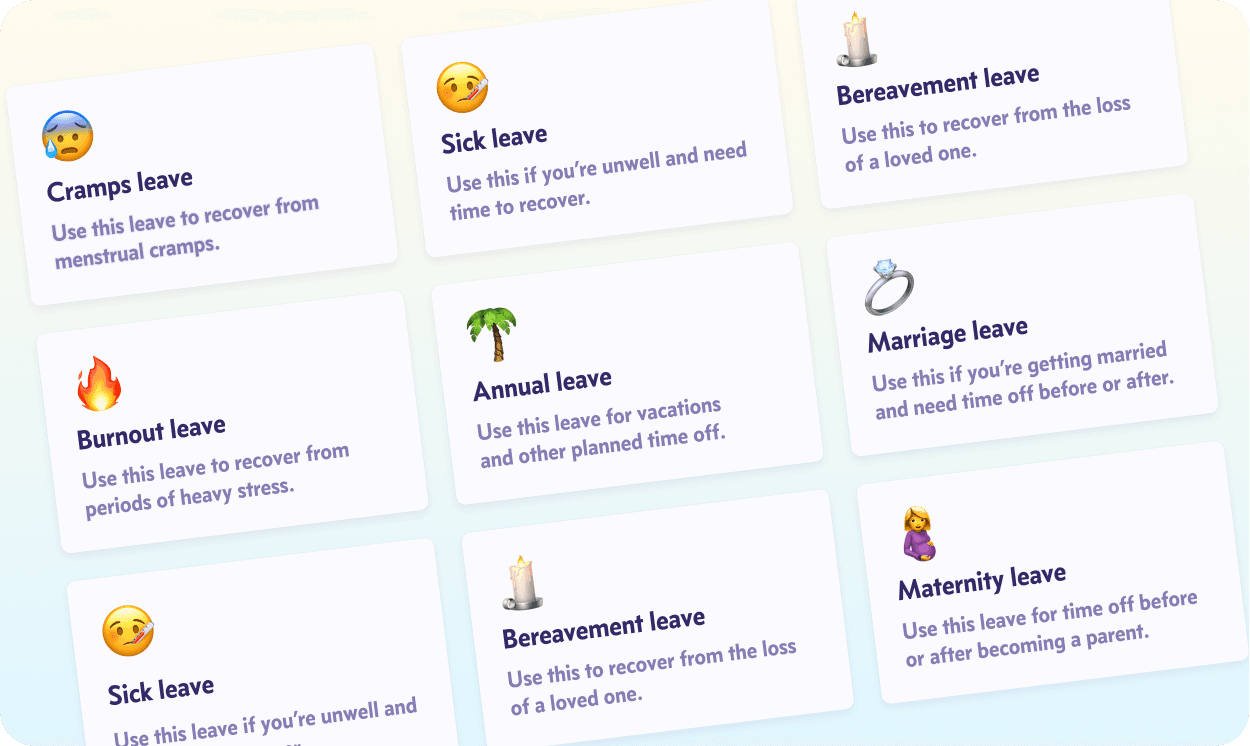Leave management for startups: The ultimate guide
Mar 31, 2023

If you’re involved in a start-up, chances are your list of priorities is long and ever-changing. The first few months generally operate on a “let’s wing it” policy since everyone’s trying to find their footing — we know, we’ve been there.
This might work for a while. But once we get used to the lack of a solid structure, it’s a slippery slope from there. It might be ‘unconventional’ and ‘flexible’ to take things one day at a time. But the truth is that many facets of running a start-up need a skeletal framework.
One such rock to build a foundation for any workplace is a leave management system that works for who it’s made for: the employees.
What is leave management?
Leave management is a set of processes that help organisations manage employee time off, from application and approval to tracking and carry forwards.
Leave management might be one of those non-fun processes that organisations have to carry out, but there's no denying that it ties into everything at work. Leave management influences payroll, capacity planning, team communication, project plans, employee productivity, even retention.
Why do companies of all sizes need leave management?
Navigating employee time off from work without a proper system in place can be quite the minefield. Small slips can lead to big disasters like resource crunches, payroll mishaps, even legal issues. Hacky approaches might save money, but they cost time and resources that you can't regain.
All of this can lead employees to take lesser time off than they're entitled to — and with the long-drawn processes and possible confusion, we can't blame them! This can also put an incredible amount of pressure on employers and managers who might find themselves stuck between a rock and a hard place.
Leave management for statutory compliance
In some states of India and other countries, leave management is a statutory compliance need. Organisations are expected to have complete records of how many paid leave days each employee has been granted. In Karnataka, for example, the rules around the Register of Leave for Wages are enforced by the Forms F and Form 14.
Leave management for capacity planning
Capacity planning is a delicate balance of employee availability, capital, and demand. You'd agree that two out of three isn't ideal in this case, right?
Without a leave management system, that's pretty much what happens: you can't account for employee availability. You might have little to no insight into who might be on leave during a project period — and the lack of such a record will affect project planning and billing.
Leave management for checking absenteeism and presenteeism
Both presenteeism (being at work for longer than is required) and absenteeism (prolonged time away from work) can be red flags that you need to spot early on. A Mercer study shows that absences result in 19% of net lost productivity per day, and the average cost of employee absence is equal to 36% of their salary. Yikes.
Leave management involves keeping clear historical records of leave taken (or not taken), which is vital when spotting worrying patterns. These systems eventually pay for themselves because they save you thousands of dollars and even improve productivity, not just bring it back to normal!
What are the benefits of leave management?
What's easy when there are three people in an organisation becomes a chore when there are a hundred. And that's the case with leave management, too! Once upon a time, you might've been able to get away with spreadsheets and email notifications — but as your teams grow, you need simpler processes and cleaner workflows.
Leave management isn't only about preventing mishaps. It's also about bringing benefits to your team members to help them work smarter and live better.
More freedom for CXOs and HR teams
Do you imagine something like this when you think of time-off requests coming in via email or messages?
As if the influx of emails weren't enough, HR also has to keep track of who's on leave when and for how long. Leadership needs this information for capacity planning, ensuring compliance, and taking care of their teams. Phew — it's enough to make anyone want to pull their hair out.
Luckily, leave management systems make life a lot easier. Leave requests are filed, approved and stored through a single platform. You'll have access to records stretching back many months, in case you ever need to dig through the archives. And if your choice of leave management is slick enough (like Pause), you'll see everyone's leave bookings on your calendar.
Relegating all the backend busywork to a leave management system leaves HR and CXOs with more time to pursue important tasks and look after their own wellbeing!
Clearer policies to guide team members
Far too often, employees struggle to understand their organisation's leave policies because they're unclear or unwritten. "Am I overstepping here?" "Can I take all my leave days at once?" "Does this go under casual or paid time off?" — questions like these can lead to team members feeling guilty about taking time off, or not applying for leave at all. Naturally, this can have disastrous effects on productivity and morale. It also doesn't bode well for the organisation.
This is why we highly recommend having a leave management software or system that helps you set clear leave policies. Setting boundaries and guidelines encourage team members to value their time and wellbeing and make the right decision in any context.
Better communication within and between teams
As personal as taking time off may seem, it actually involves entire teams and organisations — especially in tightly-knit ones. One person on leave might call for a redistribution of work, a change in plans, or an extension of deadlines. But if someone didn't tell their team they were taking time off... well, you can understand the chaos that would ensue.
It doesn't need to be the responsibility of the leave-taker to inform others about their schedule, and that's where leave management systems come in. With a centralised database, anyone should be able to see who's on leave when and for how long, so that they can plan accordingly. Clear historical records prevent situations like "but I didn't see your message" or "I forgot to tell everyone!" — once it's in the system, it's there for everyone to see.
More transparency for leave-related metrics
When you're running a company, transparency in capacity planning and leave balances is critical. That said, spreadsheets and email chains can only give you so much information — and often, you have to go on a wild goose chase to find what you need.
However, you'll find it much easier to track leave-related metrics over time with a leave management system. Business owners can see who isn't taking as much time off as they should or whether there are any patterns of absenteeism worth looking at. Transparency goes a long way in spotting productivity leaks and preventing them in the future. It also fosters a sense of mutual trust between teams and the establishment, which is always beneficial!
Higher productivity and employee wellbeing
Employee wellbeing is what drives successful organisations in many ways. But sadly, it's burnout that has become a rite of passage in its stead, thanks to unrealistic expectations and unmanageable workloads. Sooner or later, every employee will need time off to recuperate — but when they don't take it, and choose to push through their stress instead, overall wellbeing takes a hit.
Leave management can stop this and encourage stressed or overworked team members to take a break as soon as they need one. These records make capacity planning a breeze, such that anyone can take time off when they need to without the additional stress of divvying up their daily tasks.
What are the challenges of leave management?
As with any process critical to a successful company, leave management also comes with its fair share of challenges. It's not a walk in a park — but overcoming these challenges can benefit any organisation and its employees to no end!
Finding the right leave management software
If there ever were a delicate dance between balancing benefits, budget, and team satisfaction, it'd have to be while choosing software. That's the case with leave management software too: you have to find all the features you need at a price you like. On top of that, many organisations are trying to be more particular about the software they choose so employees feel encouraged and cared for rather than tracked and spied upon. And we love that because it means we're heading in the right direction: people-first software being the norm!
When you're looking for the perfect leave management software, we'd recommend prioritising the following features:
Self-serving portal: To apply for time off directly on the platform without needing to approach HR or managers first
Real-time leave tracking: To record every leave day ever booked by anyone in your organisation
Simple application and approval processes: To apply for time off and respond to leave requests almost immediately and without multiple approval threads
Leave balance records: To help employees make informed decisions and plan their schedules better
Customisable workweeks: To personalise workweeks for different teams or country offices
Locked dates: To ensure all hands on deck during critical workweeks
Public holiday calendars: To be aware of upcoming mandatory holidays and plan around them
Organisation-wide visibility: To ensure transparency and facilitate better capacity planning
Multiple leave policies: To accommodate the regular and special circumstances employees will face during their career
Slack integrations: To automatically inform teams about who's going to be off, when, and for how long, in Slack
Calendar integrations: To document teammates' leave bookings in your calendar so you have all the information you need right where you do your meeting planning
Data exports: To download leave records for payroll or compliance processes
Setting up empathetic leave management systems
HR teams and CXOs are often stuck between a rock and a hard place because they have to balance their teams and business. Setting up leave policies is one of those tasks that makes this dilemma starker. However, the truth is that empathetic leave policies need not value one over the other. If anything, we'd argue that people-first leave policies will always benefit an organisation in the long run, because they can influence productivity and employee happiness.
A good leave policy ideally should:
Be fair and inclusive
Be clear and understandable
Comply with government regulations and statues
Fit in well with both local culture and the larger industry
To design the ideal leave policy, we have a few tips that we put together after talking to hundreds of employees and founders:
Prioritise a healthy start-up culture from the get-go
Ask the right questions to work out the nuances and statutory requirements
Figure out the relevant leave-related government and state rules
Create room for flexibility and compassion
We've built on these tips in another article dedicated to designing the ideal start-up leave policy.
Choosing between fixed, flexible and unlimited leave policies
Unlimited PTO is all the rage in many Silicon Valley organisations and their counterparts elsewhere in the world. It seems like a super exciting perk — who wouldn't like to have endless days of summer, right?
But a word of warning: what works for one company may not work for another. Some organisations have trialled unlimited leave policies only to find that teams started taking fewer breaks and generally felt less productive. That said, fixed leave policies can be cookie-cutter-like, rigid, and not very empathetic.
We'd recommend meeting them both in the middle with a flexible leave policy. Here, you can specify the number of vacation days you'd like everyone to take in a year so they don't burn out. At the same time, you can also provide unlimited leave for exceptional circumstances (such as bereavement or becoming a new parent), so teammates don't feel any extra pressure.
Add the mandatory state and national public holidays to the mix, and you have the makings of an excellent leave policy!
Prioritising features on a limited budget
Organisations exploring their first leave management system might spring for the whole HR suite shebang, only to realise they use only a handful of their features. This can be quite the money sink in the long run, especially if yours is a young company, a small team, or one on a tight budget.
When exploring leave management software as a start-up or small business, we'd highly recommend starting with a dedicated tool that takes care of immediate needs. Pause, for example, helps you manage time off with simple application and approval processes and delightfully designed dashboards. Pause helps you with leave management alone, and doesn't claim to do anything else. If that's what you need, that's what you should get. This way, you don't spend an obscene amount on features you won't use any time soon but you'll also get the automated power of the ones that you do use. That's a win, if you ask us!
As you grow, you might find yourself needing more features and integrations. At this juncture, if you think it's the right time to spring for a complete HR suite, then go for it!
The final word: Leave management can save the day
We sound like we're exaggerating, but we're not. Leave management can prevent business disruption, reduce harmful overtime, increase team morale and reduce employee turnover. And if you have the right leave management software, it can make clear communication the norm and help you nail capacity planning.
So yeah, leave management can save the day — and the perfect leave management software can take you to new heights!
Features you need for a price that you like
Pause is the ideal leave management tool for start-ups, small businesses and agencies that are people-focused, culture-centric and empathetic. Don't just take our word for it — popular organisations including Slice, The Ken and Obvious swear by Pause.


